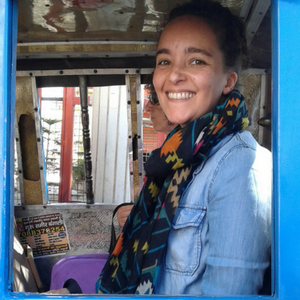In this blog-series accompanying our project of updating the Peace and Conflict Studies lectures (we call it PACS 164-c), Kimberlyn David reviews some of the key material of the course from a personal lens in an effort to generate personal reflection and the application of course content. Comment boxes are open below!
* * *
Wyalusing, PA, 1982. I’m a nine year-old and in the third grade. The school bus rolls up to our stop, and I climb aboard. “N*****!” comes a single shout from the back, then a chorus of voices chanting “N*****, n*****, n*****!” quickly fills the bus. I don’t know what this word means, but it’s clearly directed at me and it’s not intended to make me feel good. The bus driver glances at me and says nothing. I shuffle to the first empty seat and scoot as close to the window as possible. My classmate Vito, one of the school’s most popular kids, sits next to me and tells the shouters to shut up, and they do. I cry, and Vito says that it’s OK.
This childhood memory arose as I watched A Time for Justice, Charles Guggenheim’s 38-minute film about racial segregation in the U.S. South and the nonviolent successes of the Civil Rights Movement (the film is available on YouTube, in three parts). I cried while watching this moving documentary. Initially, I sobbed out of sadness that we humans devote so much energy to hating and hurting one another. Then tears of gratitude rolled out for the courage, grace, love and commitment of those who systematically worked for the freedom I was born into—the freedom, namely, to walk down the street without the constant threat of physical violence.
As a brown-skinned woman raised by poor white people, life has bestowed me with a three-pronged opportunity. From the hurts of racism, sexism and elitism I continuously learn to see my human sorrows and joys as inextricably linked to everyone else’s. I struggle at times with feelings of separation. A Time for Justice softened some lingering rigid inner edges, reminding me of the power of generosity and perseverance. It’s no small task to rewire our hearts and minds for peace. It’s an ongoing process full of uncertainty and potential.
 Before taking Metta Center’s latest course, I hadn’t heard the terms “strategic nonviolence” and “principled nonviolence.” I assumed that nonviolence simply meant non-harming. While strategic nonviolence refrains from harming, principled nonviolence goes much further, with the aim of transforming the individual and society. As Metta Center explains:
Before taking Metta Center’s latest course, I hadn’t heard the terms “strategic nonviolence” and “principled nonviolence.” I assumed that nonviolence simply meant non-harming. While strategic nonviolence refrains from harming, principled nonviolence goes much further, with the aim of transforming the individual and society. As Metta Center explains:
“It is a way to alter violent situations and influence others by persuasion rather than coercion, and a way to resolve differences so that all parties grow in the process as human beings and become more open to each other.”
It’s a common misperception that nonviolence is pie-in-the-sky dreaming—something that sounds pretty on paper but is otherwise purposeless. The Civil Rights and Satyagraha movements concretely show otherwise. People literally sacrificed limb and life for the sake of helping the whole of society emerge from destructiveness. In both movements, the transformations included empowering individuals—there’s no collective healing if individuals are paralyzed to the point of normalizing oppression or sliding into vengefulness. Each movement also highlighted the importance of collective action aimed at fostering unity.
Collective action in Denver, CO attracted major media attention last month when high school students walked out of classes to protest moves to erase civil disobedience from history lessons. “Lamentably, it is a historic fact that privileged groups seldom give up their privileges voluntarily,” wrote Martin Luther King in “Letter from a Birmingham Jail.” Could moves to censor people-powered history by corporate entities and their political allies be a sign that they’re increasingly desperate to hold the reins? Their power has long rested on the ability to contain and restrain dissent against their exploits. Most of us want and are ready for a new human era, one built on cooperation and freedom, the kind not affiliated with “consumer choices.” They know this.
It’s really hard not to slip into a “we” vs. “them” diatribe. And it’s incredibly tempting to resort to name-calling and finger-pointing. Media like A Time for Justice provide inspiration as well as historical evidence that nonviolence works and must be consistently nurtured. All the more reason to speed the Constructive Program plough.
While it’s challenging to see our time with total clarity, we could very well be creating a new kind of history, one in which humans honor vulnerability and celebrate life. Where do nine year-olds learn violence? The same places they learn about compassion and courage. From the adults who teach them what is possible.
I’d like my nine year-old nephew to be able to study principled nonviolence in school. I hope he can look back on today’s efforts with gratitude, as a gift to his generation. May he and all of today’s children inherit a harmonious, healthy world.








